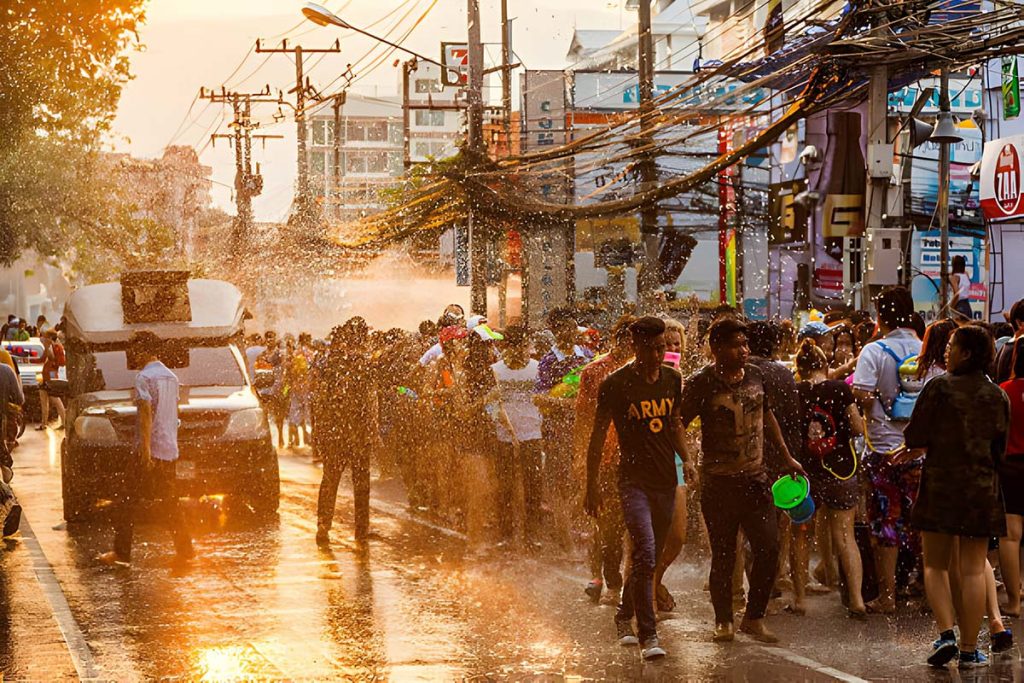
In the vibrant tapestry of Thailand’s cultural calendar, Songkran stands out as one of the most exhilarating and cherished events. Picture this: bustling streets transformed into sprawling water arenas, laughter dancing in the air, and a sense of camaraderie embracing everyone in its joyful embrace. This event is a traditional Thai New Year celebration that captures the heart and soul of the nation.
In a country renowned for its warm hospitality, rich traditions, and boundless zest for life, Songkran stands as a shining beacon of joy. It’s a spectacle unlike any other—a riotous symphony of colors, sounds, and smiles that captures the essence of Thai culture in its purest form.
What is the Thai New Year Festival Songkran?
Songkran, rooted deeply in Thai tradition, marks the Thai New Year’s national holiday. Held annually on the 13th of April, the festivities extend over the next two days, creating a jubilant party atmosphere across the land. But what does “Songkran” really mean?
Derived from the Sanskrit word saṃkrānti, meaning “transformation” or “change,” the term encapsulates the essence of this joyous occasion. As the sun shifts from Pisces to Aries in the zodiac, marking a new beginning, Songkran heralds the arrival of spring and renewal.
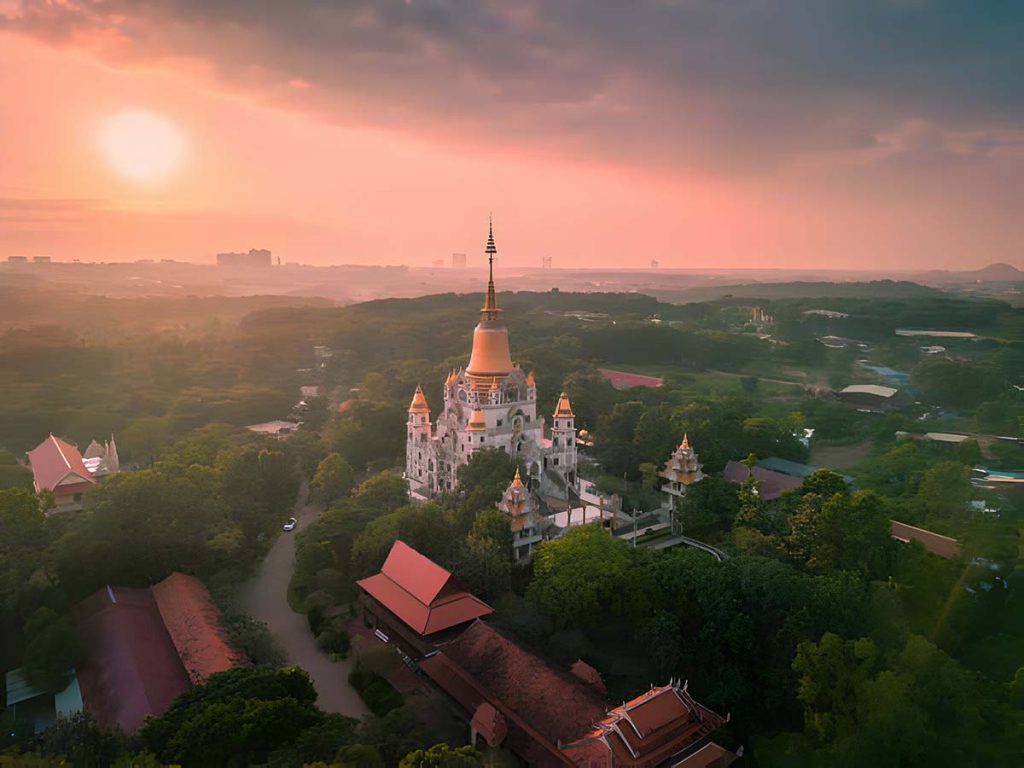
Origins and Legends of This Traditional Thai festival
In the annals of Thai tradition lies a captivating tale that speaks to the origins of the Songkran festival — a story steeped in myth and the vibrant tapestry of Buddhist folklore.
Picture a bustling city nestled in the heart of Suvvannabhumi, where Bodhisattva graced the humble abode of a simple farmer. But beneath the surface of prosperity, a shadow loomed, casting its pall over the once-thriving community. Indra, the king of Devas, gazed upon the city from his celestial perch, dismayed by the rampant corruption and moral decay that had taken root.
In a world where respect for elders waned, compassion for the needy faltered, and the tenets of Dhamma seemed but distant echoes, Indra proclaimed a timeless truth: “Glory lies in faith, and without Dhamma, there can be no true glory.” And so, the city found itself adrift in a sea of suffering—plagued by drought, scarcity, and the stench of decay.
But hope flickered on the horizon, as Bodhisattva rallied the people in prayer and purpose. Turning to Mother Earth for solace, they sought guidance and redemption. In her boundless compassion, she revealed the path to salvation—a journey marked by faith, humility, and reverence for the teachings of Dhamma.
With newfound resolve, Bodhisattva and his comrades tilled the earth, sowing seeds of hope amidst the barren landscape. As the sun traversed the heavens and entered the constellation of Aries, a bountiful harvest awaited—a testament to the power of faith and collective action.
On the day of reckoning, elders were honored, and generosity flowed freely as the community rejoiced in their newfound prosperity. And as Indra beheld the city once more, he saw not just a renaissance of spirit, but a reaffirmation of humanity’s intrinsic goodness.
And so, the tradition of Songkran was born—a celebration of renewal, unity, and the enduring spirit of Dhamma. As the years passed, households across Southeast Asia embraced the rituals of cleansing and homage—paying tribute to elders, sharing blessings with the less fortunate, and reveling in the joy of shared camaraderie.
So, as you immerse yourself in the vibrant hues of Songkran and Thailand, remember the timeless wisdom that lies at its heart—a reminder that in faith, in compassion, and in community, we find the true essence of glory.
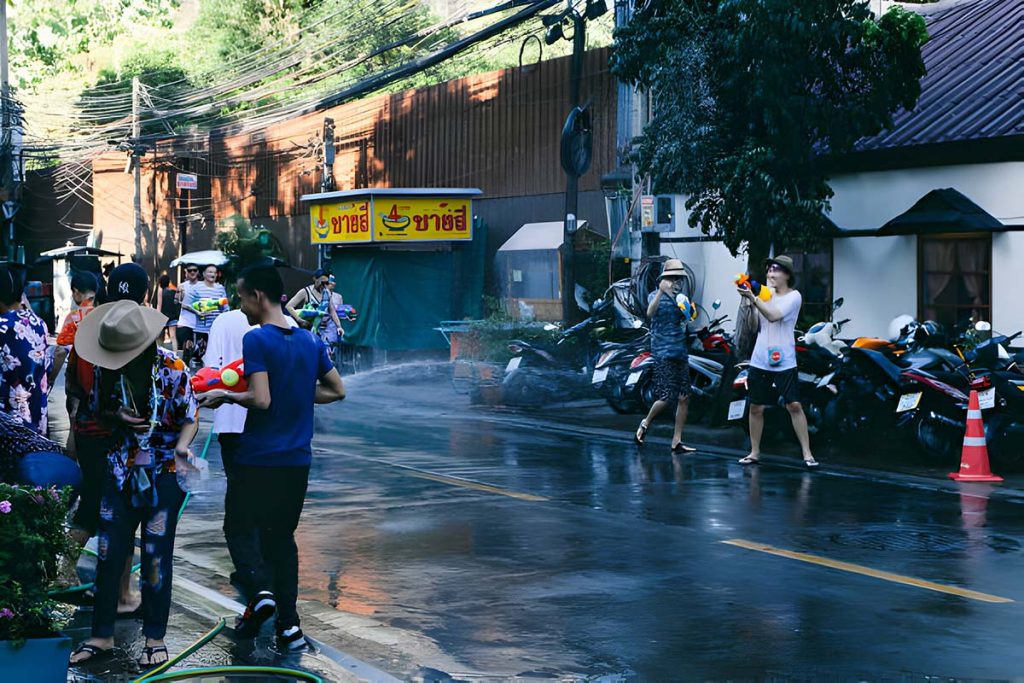
New Year Traditions
As the sun ushers in the dawn of Maha Songkran on the 13th of April, the festivities kick off with fervor. Traditional rituals such as merit-making at local temples and offerings to Buddhist monks symbolize purification and renewal. Water pouring ceremonies, a hallmark of Songkran, epitomize the cleansing of sins and the shedding of past burdens.
But perhaps the most iconic aspect of Songkran is the Water Festival itself. From Bangkok to Chiang Mai, the streets of Thailand transform into battlegrounds of joy as revelers, young and old, engage in epic water fights. Parades fill the air with music and color, while the crowning of “Lady Songkran” adds a touch of regal splendor to the proceedings.
Embracing Unity and Tradition
At its core, Songkran is a celebration of unity, family, and tradition. It is a time when loved ones reunite, elders are revered, and the bonds of community are reaffirmed. Through acts of generosity and compassion, the spirit of Dhamma permeates every aspect of the festivities, reminding us of the values that truly define us.
So, if you ever find yourself in Thailand during the month of April, do not miss the opportunity to immerse yourself in the magic of Songkran. Let go of inhibitions, embrace the splash, and join in the joyous chorus of laughter and celebration. For in the waters of Songkran, we find not just renewal, but the timeless spirit of Thailand itself – vibrant, welcoming, and ever-resilient.
Buddhist Traditions and Songkran
Amidst the uproarious water fights and lively festivities of Songkran, it’s important to pause and appreciate the profound religious significance that underpins this joyous occasion. Rooted deeply in Buddhist tradition, Songkran marks the Thai New Year and is celebrated as a time of spiritual reflection, renewal, and reverence. At its core, Songkran is a celebration of gratitude for the blessings of the past year and a heartfelt prayer for prosperity in the year to come.
Throughout Thailand, in the capital Bangkok or its remote islands, temples come alive with devotees looking to party and to pay homage to Buddha for three days, offering alms to monks, and participating in sacred rituals symbolizing purification and renewal. Water, a precious symbol of life and cleansing, is poured over a Buddha statue and elders hands as a gesture of respect and blessing.
So, as we revel in the jubilant spirit of Songkran, let us also take a moment to honor its profound religious significance and the timeless teachings of compassion, gratitude, and renewal that it embodies.
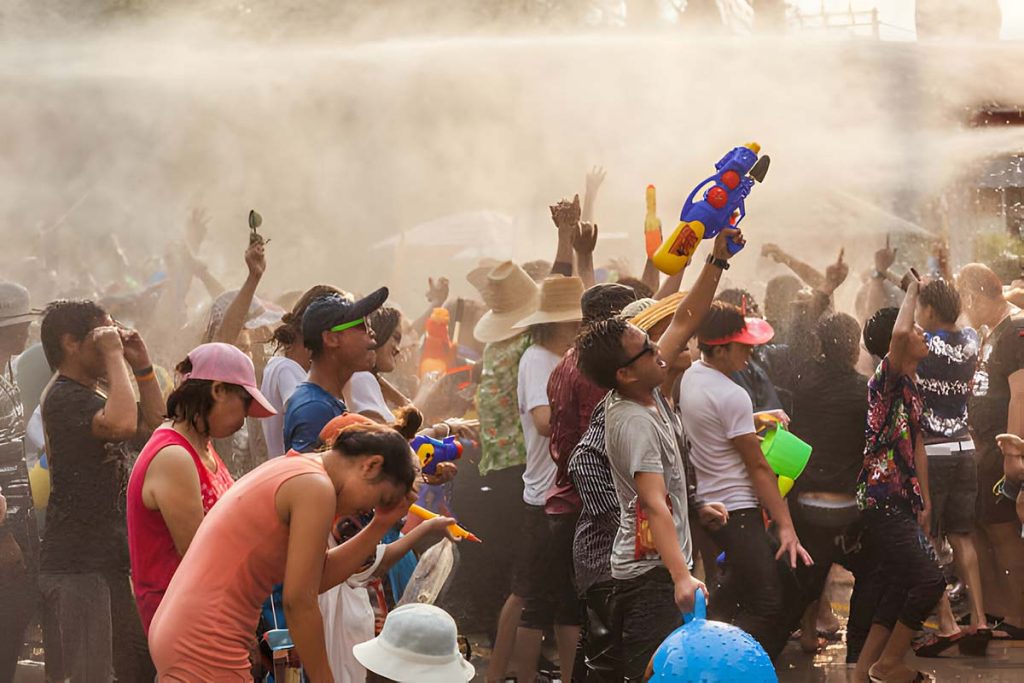
Songkran New Year Celebrations FAQS
Where is the best place to enjoy the Songkran traditions in 2024
If you’re seeking the ultimate Songkran experience in 2024, look no further than Thailand’s bustling city of Chiang Mai! Renowned for its exuberant festivities and vibrant atmosphere, Chiang Mai transforms into a water wonderland during Songkran. Picture yourself amidst the throngs of smiling faces, armed with water guns and buckets, ready to partake in the world’s largest water fight.
But the celebrations don’t stop there— the city’s ancient temples provide a serene backdrop for traditional rituals and blessings, offering a perfect blend of spirituality and revelry. So, pack your sunscreen and your sense of adventure, and head to Chiang Mai for an unforgettable Songkran celebration that will leave you soaked in joy and memories to last a lifetime!
Is Songkran new year safe in Thailand?
From Bangkok to the beaches, Songkran is a notoriously dangerous time on Thailand’s roads due to drunk driving and water splashing. It’s best to avoid travelling during the festival. Use public transport while in the city to avoid road accidents.
What do you wear to Songkran water festival?
Wondering what to wear whilst respecting Songkran traditions? Keep it simple and comfortable! For guys, opt for swimming shorts paired with a lightweight t-shirt to keep cool while you join in the water fun. Ladies, consider wearing a swimsuit underneath shorts and a shirt for both style and practicality.
With all the splashing and spraying, it might also be wise to bring along a raincoat to stay dry between water battles. And don’t forget your trusty water gun to fully immerse yourself in the celebrations!
Why do you squirt people in the street with water at Songkran festival?
Ever wondered why people joyfully squirt each other with water in the streets during Songkran? Well, it’s not just about staying cool in the scorching April heat—there’s a deeper meaning behind the playful water fights. Songkran, the Thai New Year festival, symbolizes the washing away of the past year’s misfortunes and the welcoming of a fresh start.
Water throwing is a gesture of cleansing and renewal, a way to celebrate and wish each other luck and prosperity for the year ahead. Plus, it’s just plain fun! So, next time you find yourself drenched from head to toe in the midst of a Songkran water battle, remember that you’re not just getting wet—you’re partaking in a cherished tradition of joy, unity, and new beginnings.
Any taboos I should be aware of at this Thai festival ?
While Songkran is a time of jubilant celebration and merrymaking, there are indeed some taboos to be mindful of during this auspicious occasion. One such taboo is the avoidance of wearing revealing clothing, as Songkran is deeply rooted in traditional values and respect for elders. It’s also considered inappropriate to pour water on monks, pregnant women, young people, or individuals who are clearly not participating in the festivities.
Additionally, throwing water at people’s faces or using ice-cold water can be seen as disrespectful. It’s essential to approach the festivities with a spirit of joy and camaraderie while being mindful of cultural sensitivities and traditions. So, while you’re splashing and spraying water to your heart’s content, remember to do so with respect and consideration for others.
Can I drink alcohol at Songkran?
During the Songkran festival, it’s generally accepted and common for people to drink alcohol as part of the thai new year celebration. Many establishments, especially in tourist areas, offer alcoholic beverages to revelers looking to enhance their festive experience. However, it’s important to exercise moderation and drink responsibly, especially considering the outdoor nature of the festivities and the hot weather.
While alcohol can add to the fun and convivial atmosphere of Songkran, it’s essential to prioritize safety for oneself and others while partaking in the celebrations. Additionally, some areas may have restrictions or regulations regarding public drinking, so it’s advisable to be aware of local laws and customs.
Ultimately, enjoying Songkran with a refreshing drink in hand can be a delightful part of the experience, but always remember to do so responsibly.
What to eat at Songkran?
As you navigate the bustling streets and vibrant festivities, be sure to keep your energy levels high with a feast fit for royalty. From savory street food stalls to traditional treats passed down through generations, this traditional Thai new year celebration offers a culinary adventure like no other.
First up on the menu: the quintessential Thai street food experience. With the smell of shrimp paste in the air, picture yourself savoring piping hot bowls of fragrant Tom Yum soup with local thai people, slurping up silky strands of Pad Thai noodles, and indulging in crispy spring rolls bursting with flavor.
But why stop there? Dive into a plate of one of our favorite dishes; fiery green curry, crispy fried chicken, or succulent grilled satay skewers—all washed down with a refreshing Thai iced tea or a zesty lime soda.
But let’s not forget the sweet side of Songkran! After all, what’s a celebration without a little indulgence? Treat yourself to a mouthwatering array of Thai desserts, from sticky rice with mango to creamy coconut ice cream topped with roasted peanuts and sweet syrup.
And for those craving a taste of tradition, don’t miss out on Khanom Tom—a delightful coconut dumpling filled with caramelized palm sugar and served with grated coconut, a true Thai delicacy that’s sure to satisfy your sweet tooth.
What is White Songkran?
Ah, “White Songkran”—the calm, serene cousin of its splash-tastic counterpart! Picture this: designated streets cordoned off, a serene atmosphere enveloping the air, and a gentle sprinkling of water replacing the wild water fights. White Songkran offers a more subdued and traditional take on the festivities, perfect for families, young people, and those seeking a quieter celebration as the year begins.
In this oasis of tranquility, you won’t find the raucous revelry or rowdy crowds. Instead, attendees are encouraged to dress conservatively and adhere to a more subdued vibe. With no alcohol in sight and noise levels kept in check, it’s the ideal setting for families with young ones in tow. So, if you’re looking for a more relaxed and family-friendly way to experience the magic of Songkran amid buddha statues and traditional dishes of Thai culture, look no further than “White Songkran”—where tradition meets tranquility in a splash-tastic celebration like no other.
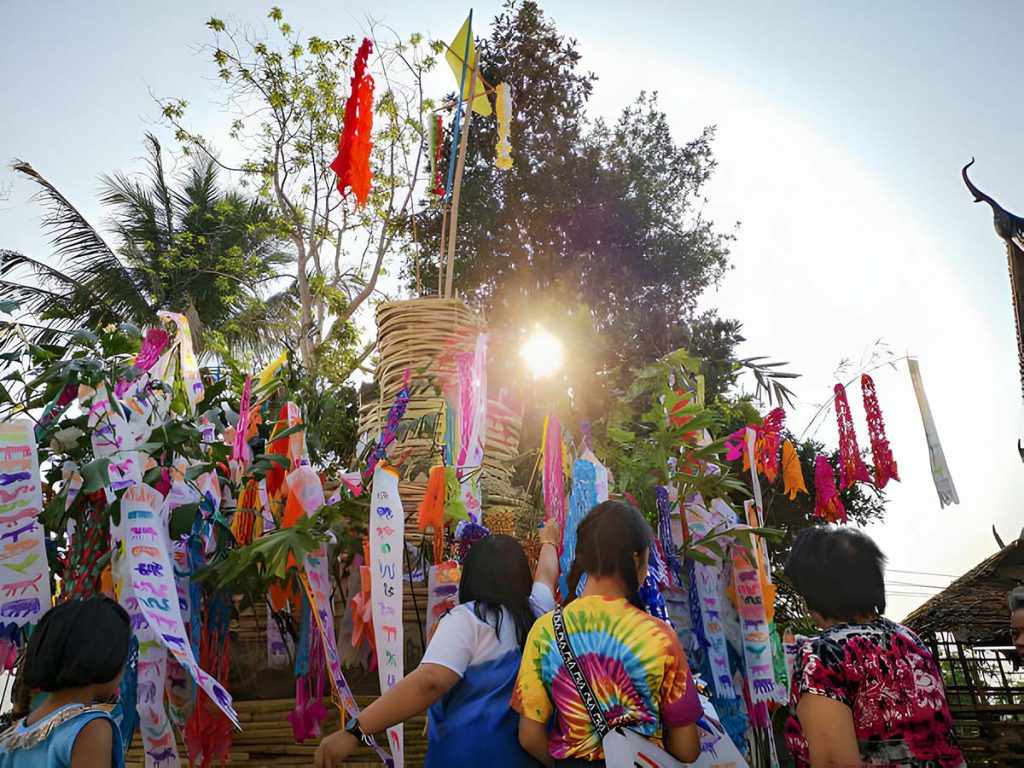
How to get to Songkran festival
Getting to the Songkran festival in Thailand can be an adventure in itself, but fear not! Here’s a handy guide to help you navigate your way to this exhilarating celebration whether you’re already in the country or not.
By Air
The most common and convenient way to reach Thailand for Songkran is by flying into the country and landing at one of the major international airports, such as Suvarnabhumi Airport in Bangkok or Chiang Mai International Airport. With numerous airlines offering direct flights from major cities around the world, getting to Thailand is easier than ever.
By Land
If you’re already in Southeast Asia or neighboring countries, you can also reach Thailand by land. Thailand shares borders with Myanmar, Laos, Cambodia, and Malaysia, making it accessible via bus, train, or even car. Just be prepared for potential border crossings and immigration procedures.
By Sea
For a more unconventional and scenic route, consider arriving in Thailand by sea. Cruise ships and ferries operate routes to various ports in Thailand, including Phuket, Koh Samui, and Pattaya. This option allows you to combine your journey with a relaxing ocean voyage.
By Bus or Train
If you’re feeling adventurous and want to experience the local culture and scenery, consider taking a bus or train within Thailand itself. The country has an extensive network of buses and trains that connect major cities and regions, allowing you to soak in the sights and sounds along the way.
By Tuk-Tuk or Taxi
Once you’ve arrived in Thailand, getting to the specific location of the Songkran festival may require additional transportation. Tuk-tuks and taxis are readily available in most cities and can take you directly to the heart of the festivities.
No matter how you choose to get there, arriving at the Songkran festival is just the beginning of an unforgettable adventure. So pack your water gun, don your most festive attire, and get ready to join in the fun of Thailand’s most exhilarating celebration, don’t forget to check in with the Thai tourism authority for further information.
Conclusion
As we come to the thrilling conclusion of our Songkran adventure guide, armed with all the knowledge and inspiration visitors need to make a splash at Thailand’s most vibrant festival, there’s just one thing left to do: join the local thai people and dive in headfirst and embrace the joy, laughter, and camaraderie that define this extraordinary holiday packed with culture.
From the bustling streets of Chiang Mai to the tranquil temples of Bangkok, Songkran beckons with promises of renewal, unity, and endless fun. So, get ready for splashing water, good fortune, pad thai gallore, and prepare for an aquatic adventure like no other.
Whether you’re a seasoned Songkran veteran or a first-time reveler (or traveller to Thailand), one thing’s for sure: the memories and friends you make during this exuberant festival will last a lifetime. So, let the water battles begin, the blessings flow, and the laughter echo through the streets—because at the great Songkran, every splash is a celebration of culture, life, love, and the boundless spirit of Thailand